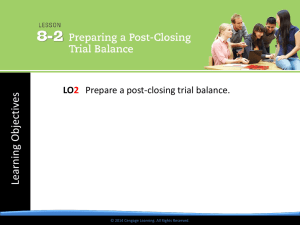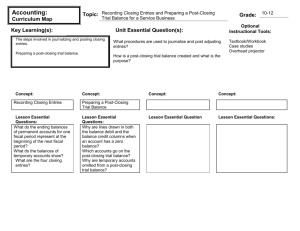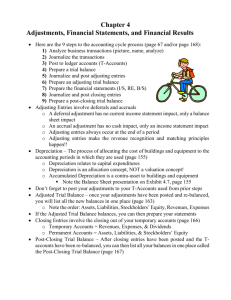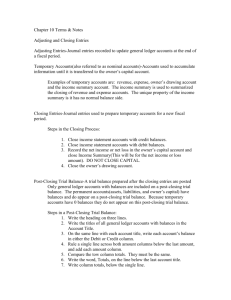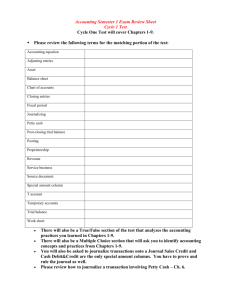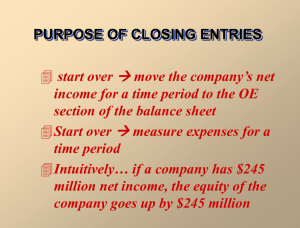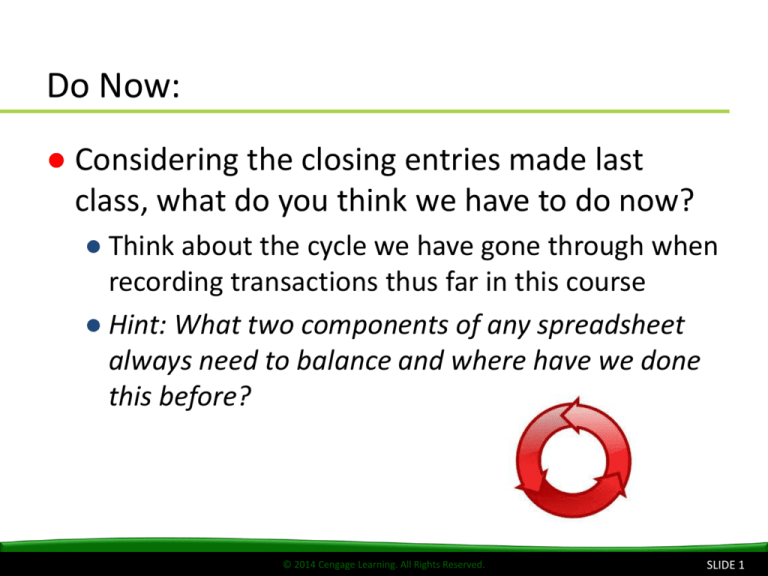
Do Now:
● Considering the closing entries made last
class, what do you think we have to do now?
● Think about the cycle we have gone through when
recording transactions thus far in this course
● Hint: What two components of any spreadsheet
always need to balance and where have we done
this before?
© 2014 Cengage Learning. All Rights Reserved.
SLIDE 1
Class Activity:
● Five cups labeled either Sales, Expenses,
Income Summary, Drawing, and Capital
● Pieces of paper have titles and amounts of Sales,
$12,000…Expenses, $9,800…Income Summary,
blank…Drawing, $200…Capital, $2,390
● Transfer strips of paper to appropriate cup to exemplify
four types of closing entries
● Others evaluate/assess decision by classmate
© 2014 Cengage Learning. All Rights Reserved.
SLIDE 2
Lesson 8-1
Lesson 8-1 Audit Your Understanding
1. What do the ending balances of permanent
accounts for one fiscal period represent at
the beginning of the next fiscal period?
ANSWER
Beginning balances
© 2014 Cengage Learning. All Rights Reserved.
SLIDE 3
Lesson 8-1
Lesson 8-1 Audit Your Understanding
2. What do the balances of temporary accounts
show?
ANSWER
Changes in the owner’s capital account for
a single fiscal period
© 2014 Cengage Learning. All Rights Reserved.
SLIDE 4
Lesson 8-1
Lesson 8-1 Audit Your Understanding
3. List the four closing entries.
ANSWER
1. An entry to close income statement accounts with
credit balances.
2. An entry to close income statement accounts with
debit balances.
3. An entry to record net income or net loss and close
the Income Summary account.
4. An entry to close the owner’s drawing account.
● 8-1 Work Together on Front Board
© 2014 Cengage Learning. All Rights Reserved.
SLIDE 5
Lesson 8-2
General Ledger Accounts after Closing Entries
Are Posted
LO2
When an account has a zero balance,
lines are drawn in both the Balance Debit
and Balance credit columns
© 2014 Cengage Learning. All Rights Reserved.
SLIDE 6
Lesson 8-2
General Ledger Accounts after Closing Entries
Are Posted
© 2014 Cengage Learning. All Rights Reserved.
LO2
SLIDE 7
Lesson 8-2
Post-Closing Trial Balance
LO2
● A trial balance prepared after the closing
entries are posted is called a post-closing trial
balance.
● Only general ledger accounts with balances are
included on a post-closing trial balance
● Permanent accounts (assets, liabilities, owner’s capital)
● Temporary accounts (INCOME SUMMARY, revenue,
expenses, and drawing) are closed and have zero
balances, so they don’t appear on a post-closing trial
balance
© 2014 Cengage Learning. All Rights Reserved.
SLIDE 8
Lesson 8-2
Post-Closing Trial Balance
Heading
LO2
1
Account
Balances
Account
Titles
3
2
4 Single
Totals
Rule
6
Compare Totals
5
Double Rule 8
© 2014 Cengage Learning. All Rights Reserved.
7
Record Totals
SLIDE 9
Lesson 8-2
Accounting Cycle for a Service Business
LO2
● The series of accounting activities included in
recording financial information for a fiscal
period is called an accounting cycle.
● Concept “Accounting Period Cycle”
● Class Activity: 8-2 WT
● Complete as class by explaining answers to
different parts of problem (answer and where you
found it specifically)
© 2014 Cengage Learning. All Rights Reserved.
SLIDE 10
Group Activity:
● In groups of 2, create a poem/song about the process we have
undergone in this class from the time a transaction was identified
to the point at which we reached today.
● **Hint: remember to include ALL types of journal entries**
● **Hint: you have used five different spreadsheets to do all of the
accounting work thus far, with the exception of the checking account
chapter work…one spreadsheet is used twice**
● You will also create an illustration to accompany your poem/song
while you present so that we can visualize the process you are
explaining
● Presentations to follow
● Once each presentation ends, we will have a class evaluation of
groups’ accuracy using a scale of 1-5 on white boards
● Class Discussion about which items were correct/incorrect in each cycle
© 2014 Cengage Learning. All Rights Reserved.
SLIDE 11
Lesson 8-2
Accounting Cycle for a Service Business
1.
2.
3.
4.
5.
1
2
8
3
7
6
4
5
LO2
Analyze transactions
Journalize
Post
Prepare work sheet
Journalize and post
adjusting entries
6. Prepare financial
statements
7. Journalize and post
closing entries
8. Prepare post-closing trial
balance
© 2014 Cengage Learning. All Rights Reserved.
SLIDE 12
Lesson 8-2
Lesson 8-2 Audit Your Understanding
1. Why are lines drawn in both the Balance
Debit and Balance Credit columns when an
account has a zero balance?
ANSWER
To assure a reader that a balance has not
been omitted
© 2014 Cengage Learning. All Rights Reserved.
SLIDE 13
Lesson 8-2
Lesson 8-2 Audit Your Understanding
2. Which accounts go on the post-closing trial
balance?
ANSWER
Only those with balances (permanent
accounts)
© 2014 Cengage Learning. All Rights Reserved.
SLIDE 14
Lesson 8-2
Lesson 8-2 Audit Your Understanding
3. Why are temporary accounts omitted from a
post-closing trial balance?
ANSWER
Because they are closed and have zero
balances
© 2014 Cengage Learning. All Rights Reserved.
SLIDE 15
Lesson 8-2
Lesson 8-2 Audit Your Understanding
4. What are the steps in the accounting cycle?
ANSWER
1. Analyze transactions.
2. Journalize.
3. Post.
4. Prepare work sheet.
5. Journalize and post adjusting entries.
6. Prepare financial statements.
7. Journalize and post closing entries.
8. Prepare post-closing trial balance.
© 2014 Cengage Learning. All Rights Reserved.
SLIDE 16
Question then CLOSE
● Create questions regarding chapter 8 that you
feel are essential to answer in order to be able to
complete closing entries and the post-closing trial
balance
● Others will ring bell if they know the answer
● Create an alternate method of the accounting
cycle that you believe would be more
efficient/effective when taking a transaction and
working toward a post-closing trial balance – be
innovative!
© 2014 Cengage Learning. All Rights Reserved.
SLIDE 17

